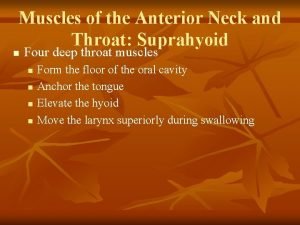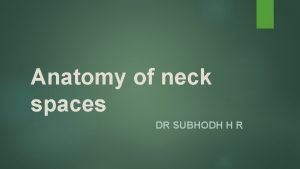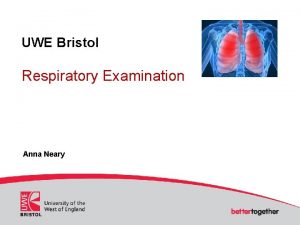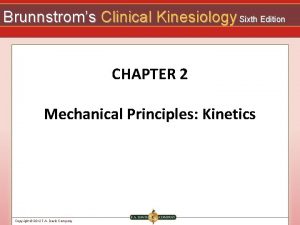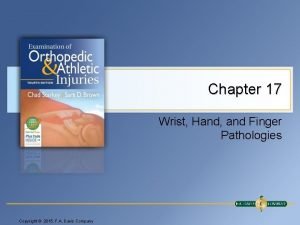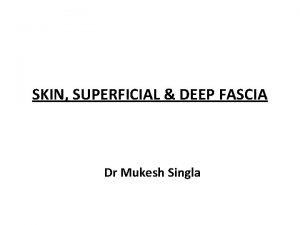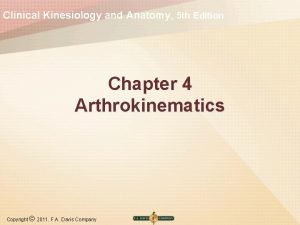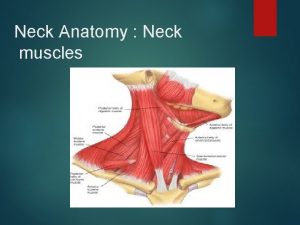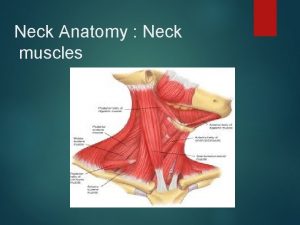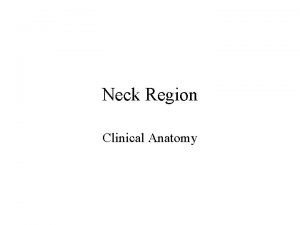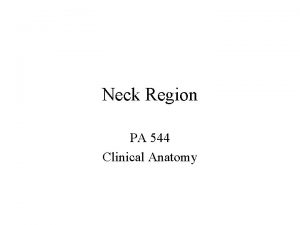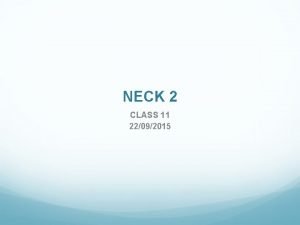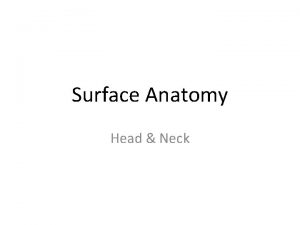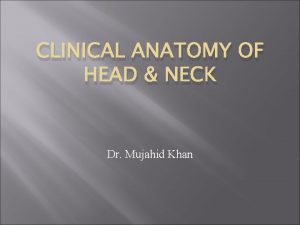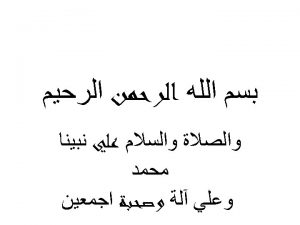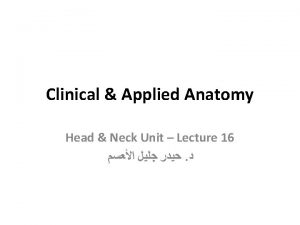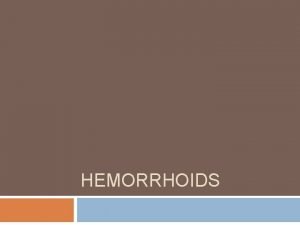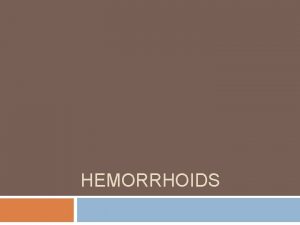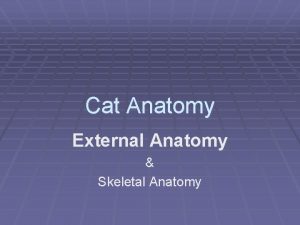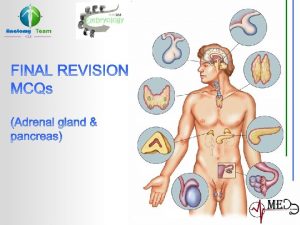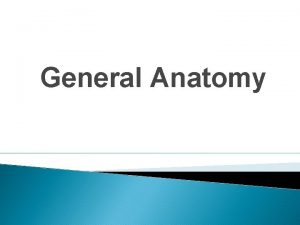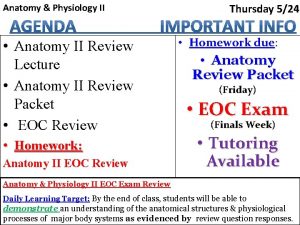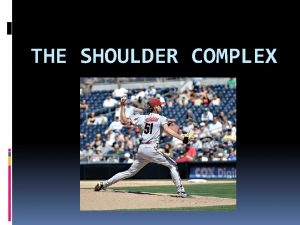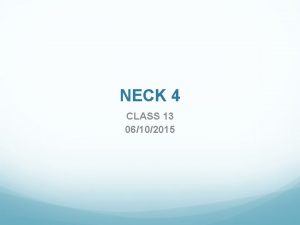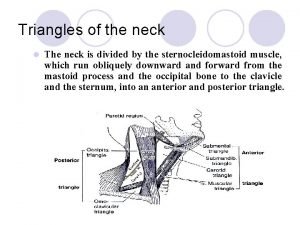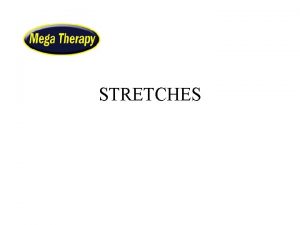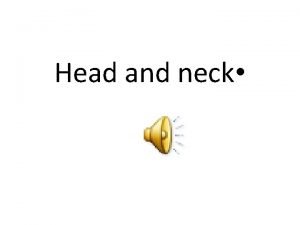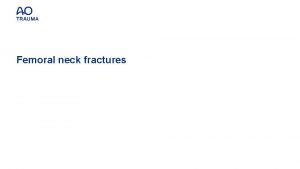Clinical Anatomy of the Neck The neck is





































- Slides: 37

Clinical Anatomy of the Neck The neck is conveniently thought of as the tissue surrounding the 7 cervical vertebrae. Dr. Zahid Kaimkhani M. D, M. Phil , Ph. D Dr. Zahid aimkhani 1

Clinical Anatomy of the Neck § The clinical anatomy of the H & N is important to know; because the structures located here allow us : § to think & speak § See & hear § Taste & smell § House the nervous system control center that’s in charge of everything that happens in the body. Objectives § to comprehend the topographic anatomy of the neck region § acquire relevant information of direct clinical importance without unnecessary details of pure academic importance. § interpret anatomical relationships to common clinical conditions § apply the knowledge in solving clinical problems Dr. Zahid aimkhani 2

Clinical Anatomy of the Neck The features of the neck included: • Surface anatomy & general topography of the neck • Cervical spine • The fascial compartments of the neck • Tissue spaces of the neck • Triangles of the neck • Thyroid & Parathyroid glands • Larynx • Pharynx • Trachea • Great vessels of the neck • Cervical sympathetic trunk • Root of the neck Dr. Zahid aimkhani 3

The Cervical Spine Salient Features: Identified by the foramen transversarium , transmits the vertebral artery, the vein, and sympathetic nerve fibres. The spines are small and bifid (except C 1 and C 7 which are single). The atlas (C 1) has no body. The axis (C 2) bears the dens (odontoid process. C 7 is the vertebra prominens. Clinical Features: The cervical vertebrae (particularly C 7), may be fractured or, more commonly, dislocated by a fall on the head with acute flexion of the neck e. g. diving into shallow water. Dislocation may even result from the sudden forward jerk (during car or aeroplane crash). WHY NOT FRACTURE- the relatively horizontal intervertebral facets of the cervical vertebrae allow dislocation to take place without their being fractured. Cervical disc prolapse- This may sometimes occur at the lower cervical intervertebral discs C 5/6 and C 6/7. Dr. Zahid Kaimkhani 4

Clinical Anatomy of the Neck – Surface Anatomy of the Neck In the midline, from above down, can be felt: • the hyoid bone—at the level of C 3; • the notch of the thyroid cartilage—at the level of C 4; • the cricothyroid ligament—important in cricothyroid puncture; • the cricoid cartilage—terminating in the trachea at C 6; • the rings of the trachea, over the second and third of which can be rolled the isthmus of the thyroid gland; • the suprasternal notch. • The hard palate – ant arch of the atlas (C 1) • The lower border of the mandible lies b/w C 2 &3 vertebrae. Dr. Zahid aimkhani 5

Clinical Anatomy of the Neck – Surface Anatomy of the Neck The cricoid is an important level in the neck; It corresponds to: • the level of the 6 th cervical vertebra • the junction of the : larynx with the trachea pharynx with the esophagus • the level at which the inferior thyroid artery and the middle thyroid vein enter the thyroid gland; • the level at which the vertebral artery enters the transverse foramen in the 6 th cervical vertebra; • the level of the middle cervical sympathetic ganglion; • the site at which the carotid artery can be compressed against the transverse process of C 6 (the carotid tubercle). Dr. Zahid aimkhani 6

General Topography of the Neck Dr. Zahid aimkhani 7

General Topography of the Neck • Cervical spines gently convex forward support the skull. • A mass of Extensor musculature lies behind the vertebrae. • A much smaller –prevertebral Flexure musculatures covered by prevertebral fascia lies in front of the vertebrae and behind the pharynx. • The face is in front of the upper part of the pharynx. • The larynx and trachea lies in front of the lower pharynx and upper esophagus. • The sternocleidomastoid is tensed helps define the triangle of the neck. • Violently clench the jaws; the platysma lying in the superficial fascia of the neck. • The external jugular vein lies immediately deep to platysma, perforates the deep fascia just above the clavicle and enters the subclavian vein. It is readily visible in a thin subject on straining like in singer hits a sustained high note or when an orthopaedic surgeon reduces a fracture. • The carotid sheath on each side of pharynx and sympathetic chain behind it. • The common carotid artery pulse can be felt by pressing backwards against the long anterior tubercle of the transverse process of C 6. • The carotid bifurcates into the external and internal carotid arteries at the level of the upper border of the thyroid cartilage; at this level the vessels Dr. Zahid aimkhani lie just below the deep fascia where their pulsation is palpable and often 8

The Fascial Compartments of the Neck Clinical Significance (CS) The fascial planes of the neck are of considerable importance to the surgeon; they form convenient lines of cleavage through which he/she may separate the tissues in operative dissections and they delimit the spread of pus in neck infections. • • The superficial fascia is a thin fatty membrane enclosing the platysma. The deep fascia can be divided into 3/4 layers or parts. 1. The enveloping / investing fascia invests the muscles of the neck (trapezius, the sternocleidomastoid, the strap muscles and the parotid and submandibular glands). CS. The external jugular vein pierces the deep fascia above the clavicle. If the vein is divided here, it is held open by the deep fascia which is attached to its margins, air is sucked into the vein lumen during inspiration and a fatal air embolism may ensue. 2. The prevertebral fascia passes across the vertebrae and prevertebral muscles behind the oesophagus, the pharynx and the great vessels. CS. Pus from a tuberculous cervical vertebra may form a midline swelling in the posterior wall of the pharynx. 3. The pretracheal fascia encloses the ‘visceral compartment of the neck’. Extending from the hyoid above to the fibrous pericardium below. 4. The carotid sheath, containing carotid, internal jugular and vagus nerve and bearing the cervical sympathetic chain in its posterior wall. Dr. Zahid aimkhani 9

The Fascial Compartments of the Neck The carotid sheath Surrounds (Contents): § the carotids arteries § IJV § Vagus nerve § Lymph nodes Extent: § The base of the skull superiorly and fuses with the pericardium inferiorly. The sympathetic chain lies behind Nerves crossing the sheath: • Glossopharyngeal. • Hypoglossal. • Spinal part of accessory. Dr. Zahid aimkhani 10

Tissue Spaces of the Neck 1. The prevertebral space behind the prevertebral fascia – closed space. 2. The reteropharyngeal Space in front of the prevertebral fascia , continuous with parapharyngeal space at the side of the pharynx and its upper part is called as infratemporal fossa. 3. The submandibular space between the mylohyoid muscle and investing layer in between hyoid and mandible. Clinical feature. the Ludwig’s angina -rare but severe cellulitis involve parapharyngeal spaces. Dr. Zahid aimkhani 11

The Triangles of the Neck Dr. Zahid aimkhani 12

Triangles of the Neck 1. To assist the description of the topographical anatomy of the neck 2. To locate the pathological lesions 3. Lymphatic drainage from H&N cancers goes to zones defines by these triangles and every neck dissection requires identifications of all essential structures to excise the LNs. 4. Carotid endarterectomy (CEA)- thormboemblismstroke. For CEA dissection of the carotid triangle & carotid sheath is required. Each side of the neck is divided into: • The anterior triangle • The posterior triangle “By the obliquely placed sternocleidomastoid muscle. ” Dr. Zahid aimkhani 13

Anterior Triangle of the Neck Anteriorly: Midline of the neck. Posteriorly: Anterior border of the sternomastoid. Superiorly: Lower margin of the body of the mandible. Roof: Skin, Superficial fascia, Platysma and the investing layer of the deep cervical fascia. Contents: Viscera of the neck Subdivided in to: 1. Submental. 2. Submandibular (Digastric). 3. Carotid. 4. Muscular by: The digastric bellies & the superior belly of the omohyoid Dr. Zahid aimkhani 14

Posterior Triangle of the Neck Boundaries Anteriorly: Posterior border of sternomastoid Posteriorly: Anterior border of Trapezius Apex : Meeting of Trapezius & Sternomastoid Base: Middle 1/3 of the clavicle Roof: Skin, Superficial fascia, Platysma and the Investing layer of the deep cervical fascia. Floor: from below upward, Scalenus anterior + , Scalenus medius, levator scapulae, splenius capitis, and semispinalis capitis + Note. The scalenus anterior and 1 st digit of serratus anterior MAY contribute to floor depending on the size of the sternocleidomastoid muscle. Dr. Zahid aimkhani 15

Posterior Triangle of the Neck Contents: Nerves: • Trunks of the brachial plexus, • Cervical plexus. • Spinal accessory. Arteries: 1 - 3 rd part of subclavian artery. 2 - Suprascapular artery. 3 - Transverse cervical artery. 4 - Occipital artery. Veins: 1 - Subclavian vein. 2 - External jugular vein Lymph nodes • • 2 -3 occipital ( enlarged in scalp infection & rubella) Numerous are supraclavicular Muscle: Inferior belly of omohyoid muscle. Dr. Zahid aimkhani 16

Sternocleidomastoid • Visible on either side of the neck. • attached to the sternum and clavicle and the mastoid process of the temporal bone of the skull. • Contracting one SCM tilts your head to that side (ipsilateral )and can rotate the head in the opposite direction. • Contracting both at the same time flexes the neck and extends the head. • The spinal accessory nerve (CN XI) provides the efferent (motor) innervation, and the afferent (sensory) innervation comes from the C 3 and C 4 spinal nerves. • Test: the face is turned to the opposite side against resistance and the muscle is palpated. Dr. Zahid aimkhani 17

The Thyroid Gland The thyroid gland is: • made up of the isthmus , 2 lateral lobes andan inconstant pyramidal lobe projecting upwards from the isthmus, usually on the left side, • Highly vascular, • Brownish-red • Located anteriorly in the lower neck, • Weighs about 25 gm (it is slightly heavier in women). • The gland enlarges during menstruation and pregnancy. • Own capsule + enclosed by Pretracheal fascia Each thyroid lobe is : 1. Pear shaped & triangular in cross section 2. Surfaces: lateral, medial & posterior The isthmus: § Firmly adherent to 2 nd , 3 rd & 4 th tracheal rings {fixation & investment in pretracheal fascia responsible for the gland movement with larynx during swallowing} Dr. Zahid aimkhani 18

The Thyroid Gland Pyramidal lobe: § Represents a development of gland from the caudal end of the thyroglossal duct. § May be attached to hyoid bone by fibrous tissue (Levator glandulae thyroideae-muscles fiber may be found in it). Accessory thyroid gland § § Lingual thyroid Near the hyoid bone Superior mediastinum (retrosternal goiter) Along the course of thyroglossal duct Dr. Zahid aimkhani 19

The Thyroid Gland Blood Supply; The superior thyroid artery, br of ECA (Ext laryngeal N is immediately behind it) The inferior thyroid artery—arises from the thyrocervical trunk and have variable relations with Recurrent Laryngeal N i. e why artery is ligated well lateral to the gland. The thyroidea ima artery—is inconstant (3%) Three veins drain the thyroid gland: The superior thyroid vein— drains the upper pole to the internal jugular vein or facial vein; The middle thyroid vein—drains from the lateral side of the gland to the IJV The inferior thyroid vein-often several—drain the lower pole to the brachiocephalic veins mainly ; one may into right brachiocephalic. Why thyroid gland bleed even all main vessels are tied during a partial thyroidectomy ? Numerous small vessels pass to the thyroid from the pharynx and trachea so that even when all the main vessels are tied, the gland still bleeds when cut across. ” Dr. Zahid aimkhani 20

The Thyroid Gland Clinical features § Thyroglossal cyst or sinus § Reterosternal goiter § Benign enlargement § Pressure on trachea- Difficulty in breathing § Pressure on esophagus – difficulty in swallowing § Carcinoma of the gland : invades its neighbors like trachea, esophagus, carotid sheath (severe hemorrhage) ; recurrent LN - affecting voice ; cervical sympathetic chain-Horner’s syndrome Dr. Zahid aimkhani 21

The Parathyroid Gland Salient Features: • usually four in number(vary from two to six). , a superior and inferior on either side; • Ninety per cent are in close relationship to the thyroid, 10% are aberrant, the latter invariably being the inferior glands. • size -a split pea and is of a yellowish-brown colour. • Position: The superior parathyroid is more constant in position, • The inferior parathyroid is most usually situated near the lower pole of the thyroid gland. The next commonest site is within 1 cm of the lower pole of the thyroid gland. • Aberrant inferior parathyroids may be found in front of the trachea and may even track into the superior mediastinum. Clinical features • These possible aberrant sites are, of course, of great importance in searching for a parathyroid adenoma in hyperparathyroidism. • The parathyroids are usually safe in subtotal thyroidectomy because the posterior rim of the thyroid is preserved. However, they may be inadvertently removed or damaged, with resultant tetany due to the lowered serum calcium. Dr. Zahid aimkhani 22

The Pharynx Nasal cavity A Oral cavity B C nx Lary A-Nasopharynx B-Oropharynx C- Laryngopharynx Dr. Zahid Kaimkhani 23

The Pharynx • • • Is a musculo-membranous tube that lies behind nasal cavity, oral cavity & larynx Extend from base of skull to C 6 vertebra where it is continuous with esophagus acts as a common entrance to the respiratory and alimentary tracts. 12 – 14 cm long By means of the auditory tube, the mucous membrane is also continuous with that of the tympanic cavity Oropharynx: Extends from soft palate (C 1) to level of upper end of epiglottis (C 3) Palatine Tonsil : “a mass of lymphoid tissue lying in a triangular recess “tonsillar sinus” between palatoglossal & palatopharyngeal arches ” Applied anatomy: Tonsillitis may cause referred pain in ear [ both tonsil & middle ear are supplied by glossopharyngeal nerve. A quinsy is suppuration in the peritonsillar tissue secondary to tonsillitis. It is drained by an incision in the most prominent part of the abscess where softening can be felt. Nasopharynx : • • Pharyngeal opening of auditory tube & tubal elevation Pharyngeal tonsil: if enlarged in children (adenoids) causing obstruction of nasophaynx & difficulty in breathing Functional Anatomty: The nasopharynx is kept opened to allow breathing by: a. The rigidity of its wall (well developed pharyngobasilar fascia) b. The lack of pharyngeal constrictors over its wall Laryngopharynx : Extends from upper end of epiglottis (C 3) to lower border of cricoid cartilage (C 6) The larynx itself bulges into this part of the pharynx leaving a deep recess anteriorly on either side, the piriform fossa, in which sharp ingested foreign bodies (for example, fish bones), may lodge. Dr. Zahid Kaimkhani 24

The Pharynx Quinsy: Applied anatomy: is suppuration in the peritonsillar tissue secondary to tonsillitis. Pharyngeal pouch It is drained by an incision in the most prominent part of the abscess • • Thru a potential gap between the thyropharyngeus and the cricopharyngeus termed the pharyngeal dimple or Killian’s dehiscence. The mucosa and submucosa of the pharynx may bulge and give rise this diverticulum. It enlarges, backward extension is prevented by the prevertebral fascia and it therefore has to project to one side of the pharynx — usually to the more exposed left. With further enlargement, the pouch pushes the esophagus aside and lies directly in line with the pharynx; most food then passes into the pouch with resulting severe dysphagia and cachexia. Spill of the pouch contents into the larynx is very liable to cause inhalation of food material into the bronchi with respiratory infection and lung abscess as possible consequences. where softening can be felt. Tonsillectomy: The paratonsillar vein, descends from the soft palate across the lateral aspect of the tonsillar capsule. It is nearly always divided in tonsillectomy and may give rise to troublesome hemorrhage. The nasopharyngeal tonsils (adenoids) are prominent in children but usually undergo atrophy after puberty. When chronically inflamed they may all but fill the nasopharynx, causing mouth-breathing and also, by blocking the auditory tube, deafness and middle ear infection. The otitis media complicates infections of the throat thru the Eustachian tube. Dr. Zahid Kaimkhani 25

The Larynx Salient Features Is respiratory organ Perform triple functions 1. An open valve in respiration, 2. A partially closed valve -phonation, 3. and a closed valve protecting the trachea and bronchial tree during deglutition. “Coughing is only possible when the larynx can be closed effectively”. Skeleton: Cartilage- the epiglottis, thyroid , cricoid and the arytenoids, corniculate & cuneiform Ligaments and membranes-Extrinsic (TH membrane & cricotracheal, hyoepiglottic & thyroepiglottic ligaments. ) Intrinsic (quadrangular membrane & CT ligament Slung from the U-shaped hyoid bone by the thyrohyoid membrane and thyrohyoid muscle. The hyoid bone itself is attached to the mandible, tongue, styloid process and pharynx. The corniculate cartilage, and the cuneiform cartilage, small nodules, no functional significance BUT might mimic pathological nodules. Anteriorly, the cricothyroid ligament, easily felt and is used in emergency cricothyroid puncture for laryngeal obstruction. Dr. Zahid Kaimkhani 26

The Larynx Clinical Features: The laryngeal nerves relationships to the thyroid arteries are practical importance in thyroidectomy Damage to the Ext. LN causes some weakness of phonation due to the loss of the tightening effect of the cricothyroid muscle on the cord. Recurrent LN: Complete division -the cord on the affected side to take up the neutral i. e. paramedian position between abduction and adduction. Luckily other cord to compensate in a remarkable way and speech is not greatly affected. If both nerves are divided, complete lost of the voice is and difficult breathing ( through the only partially opened glottis). Partially damaged or bruised “Semon’s law” apply. i. e. abductors (PCA) are affected more than the adductors. The affected cord adopts the midline adducted position. In bilateral incomplete paralysis, the cords come together, stridor is intense and tracheotomy may become essential. WHY loss of voice must always be regarded as an warning symptom requiring careful investigation. Thyroid malignancy or malignant lymph nodes in neck may damaged the either RLN. The left recurrent laryngeal nerve can be involved in (Palsy): a bronchial or esophageal carcinoma, enlarged mediastinal nodes, or may become stretched over an aneurysm of the aortic arch , the enlarged left atrium in advanced mitral stenosis may produce a recurrent laryngeal palsy by pushing up the left pulmonary artery which compresses the nerve against the aortic arch. Laryngoscopy Dr. Zahid Kaimkhani 27

The Trachea Salient Features: • • • is about 10 cm long and nearly 2. 0 cm in diameter. commences at the lower border of the cricoid cartilage (C 6) and terminates by bifurcating at the level of the sternal angle of Louis (T 4/5). Lying partly in the neck and partly in the thorax. CERVICAL PART(Relations) Anteriorly— the isthmus of TG, ITVs, SH and ST muscles; Laterally—the lobes of thyroid gland the CCA Posteriorly—the esophagus with the recurrent laryngeal Clinical Features: • • • may be compressed or displaced by pathological enlargement ‘Tracheal-tug’ characteristic of aneurysms of the aortic arch Tracheotomy and tracheostomy • Tracheotomy (making an incision in the trachea-in children) • Tracheostomy (removal of small part of wall) Indications • Laryngeal obstruction (tumors, inhaled foreign bodies) • Evacuation of excessive secretions (severe postoperative chest infection in a patient who is too weak to cough adequately) • For long-continued artificial respiration (poliomyelitis, severe chest injuries). The golden rule of tracheostomy—based entirely on anatomical Dr. Zahid Kaimkhani considerations—is ‘stick exactly to the midline’. 28

Blood Vessels of the Neck -Arteries Common Carotid Artery (CCA) • Right from brachiocephalic artery & Left arise from aortic arch. • Extent SC joint to level of upper border of thyroid cartilage PULSE- Carotid pulse in carotid triangle close to anterior border of sternomastoid, at the level of upper border of thyroid cartilage • Branches are External and Internal CAs External Carotid artery • It supplies neck, face, tongue, maxilla & scalp. Branches includes: Superior thyroid, Ascending pharyngeal, Lingual, Facial, Occipital, Posterior auricular , Maxillary and Superficial temporal. Clinical Features: • It may be surprisingly difficult to differentiate between the external and internal carotids at operation. • The common carotid artery can be exposed over the origin of the sternocleidomastoid immediately above the SC joint. • Ligation of the common carotid artery may be performed for intracranial aneurysm arising on the internal carotid. • Anastomoses between the branches ensure adequate blood supply to the brain on the affected side. Dr. Zahid aimkhani 29

Blood Vessels of the Neck -Arteries Subclavian Arteries The left subclavian artery arises from the arch of the aorta. The right subclavian artery is formed by the bifurcation of the brachiocephalic artery. Divided in to 3 parts by scalenus anterior Branches includes: • 1 st part-The vertebral artery, the thyrocervical trunk[inferior thyroid, transverse cervical, suprascapular] and the internal thoracic artery • 2 nd part — the costocervical trunk (supplying deep structures of the neck via its deep cervical branch, and the superior intercostal artery, which gives off the 1 st and 2 nd posterior intercostal arteries). • 3 rd part—gives no constant branch. Clinical Features: • The right subclavian artery is grafted end-to-side into the right pulmonary artery to short-circuit the pulmonary stenosis of the tetralogy of Fallot (MUST KNOW THE VARIATIONS) • An aneurysm of the subclavian artery is not rare; in the third part of the artery (NEVER in thoracic part). Usually pain, weakness and numbness in the arm bcz of close relation with the brachial plexus. • A cervical rib may elevate the subclavian artery and may closely simulate an aneurysm. Dr. Zahid aimkhani 30

Blood Vessels of the Neck -Veins The internal jugular vein • Begins at the jugular foramen (continuation of sigmoid sinus) and terminates by joining the subclavian vein to form the brachiocephalic vein • Lies in the carotid sheath Its tributaries are: • the pharyngeal venous plexus; the common facial vein; the lingual vein; the superior and middle thyroid veins. Superficial veins • The superficial temporal and maxillary veins join to form the retromandibular vein. Its posterior division, together with the posterior auricular vein, form the external jugular vein, whereas the anterior division joins the facial vein to form the common facial vein which opens into the internal jugular vein. • The external jugular vein enter the subclavian vein and The anterior jugular vein runs down join enter the external jugular vein. • The subclavian vein continuation of the axillary vein joins the internal jugular vein to form the brachiocephalic vein. ONLY tributary is the external jugular vein. The left also receive thoracic duct. Dr. Zahid aimkhani 31

Blood Vessels of the Neck -Veins Clinical Features: Central Venous Catheterization • to measure central venous pressure (c. v. p. ) • to allow rapid blood replacement • long-term intravenous feeding • The internal jugular vein can be cannulated by direct puncture in the triangular gap between the sternal and clavicular heads of the sternocleidomastoid immediately above the clavicle. • Feel this landmark on yourself. • The needle is inserted near the apex of this triangle at an angle of 30– 40° to the skin surface and is advanced caudally towards the inner border of the anterior end of the first rib behind the clavicle. A reflux of blood confirms venepuncture. • Subclavian venepuncture can be carried out most effectively by the infraclavicular approach Dr. Zahid aimkhani 32

The lymph nodes of the neck Salient Features: • grouped into horizontal and vertically disposed aggregates. • The horizontal nodes form a number of groups which encircle the junction of the head with the neck and which are named, according to their position. • These nodes drain the superficial tissues of the head and efferent then pass to the deep cervical nodes (although some lymph vessels pass direct to the cervical nodes, bypassing the horizontal nodes). • The vertical nodes [superficial & deep cervical groups] drain the deep structures of the head and neck. • The most important is the deep cervical group, extends along the internal jugular vein from the base of the skull to the root of the neck • The superficial cervical nodes lie along the external jugular vein, serve the parotid and lower part of the ear and drain into the deep cervical group. • Others vertical nodes are : the infrahyoid, the prelaryngeal and the pre- and paratracheal nodes. These drain the thyroid, larynx, trachea and part of the pharynx and empty into the deep cervical group. • The retropharyngeal nodes, lying vertically behind the pharynx, drain the back of the nose, pharynx and Eustachian tube; their efferents pass to the upper deep cervical nodes. Dr. Zahid aimkhani 33

The lymph nodes of the neck • Clinical features • Significant changes in the evaluation and management of lymphatic metastases in the neck during the past several decades, and knowledge of the functional anatomy of the cervical lymphatics is fundamental to the clinical management of metastasis in this region. • Significant improvements in clinical care, namely, selective neck dissection and sentinel lymph node biopsy aided by lymphoscintigraphy, have been developed and are based upon detailed studies of the pathways of metastatic spread. These advances have significantly decreased the morbidity associated with the evaluation and treatment of metastatic disease to the neck. • The jugulodigastric or tonsillar node. A constant lymph node, becomes enlarged in tonsillitis responsible for the commonest swelling to be encountered in the neck. • Block dissection of the neck for malignant disease is the removal of the lymph nodes of the anterior and posterior triangles of the neck and their associated lymph channels, together with those structures which must be excised in order to make this lymphatic ablation possible. o The block of tissue removed extends from the mandible above to the clavicle below and from the midline anteriorly to the anterior border of the trapezius behind. o The carotid arteries, the vagus, the cervical sympathetic chain and the lingual and hypoglossal nerves. The accessory nerve, passing across the posterior triangle, is usually sacrificed. Dr. Zahid aimkhani 34

The Cervical Sympathetic Trunk Salient Features: • Continues upwards from the thorax by crossing the neck of the first rib, then ascends embedded in the posterior wall of the carotid sheath to the base of the skull. Three ganglia: • the superior cervical ganglion (the largest) , the middle ganglion and the inferior ganglion (C 7+T 1 -the stellate ganglion) Note: that these ganglia receive no white rami from the cervical nerves; their preganglionic fibers originate from the upper thoracic white rami and then ascend in the sympathetic chain. . Branches: • cardiac branches and vascular plexuses along the carotid, subclavian and vertebral vessels. • to the dilator pupillae muscle (along the internal carotid artery). • Grey rami pass from the superior ganglion to cranial nerves VII, IX, X and XII. • Clinical features –Horner Syndrome • Meiosis (pupillary constriction) , due to unopposed parasympathetic innervation via the oculomotor nerve), • Partial ptosis (partial paralysis of levator palpebrae) • the face on the affected side is dry and flushed). • Enophthalmos • Causes: • Spinal cord lesions at the T 1 segment (tumour or syringomyelia), • Closed penetrating or operative injuries to the stellate ganglion • Pressure on the chain or stellate ganglion by enlarged cervical lymph nodes, an upper mediastinal tumor, a carotid aneurysm or a malignant mass in the neck. Dr. Zahid aimkhani 35

The Root of the Neck Salient Features: • Also called “The Thoracic Inlet” often called clinically “The Thoracic Outlet” Boundaries: • the 1 st thoracic vertebra, the 1 st pair of ribs and their cartilages and manubrium of the sternum Note: The KEY to the root of the neck is the “SCALENUS ANTERIOR MUSCLE” & its relations Clinical Features: • A cervical rib occurs in 0. 5% of subjects and is bilateral in half of these. • Pressure on the lowest trunk of the brachial plexus arching over it may produce paranesthesia along the ulnar border of the forearm and wasting of the small muscles of the hand (T 1). • Vascular changes (Less commonly ), even gangrene, may be caused by pressure of the rib on the overlying subclavian artery. • This results in post-stenotic dilatation of the vessel distal to the rib in which a thrombus forms from which emboli are thrown off. Dr. Zahid aimkhani 36

Dr. Zahid aimkhani 37 Clinical Anatomy of the Neck
 Anatomy of the throat and neck
Anatomy of the throat and neck Fascia thoracolumbalis
Fascia thoracolumbalis Neck fascia
Neck fascia Tactile fremitus normal findings
Tactile fremitus normal findings Brunnstrom's clinical kinesiology 6th edition
Brunnstrom's clinical kinesiology 6th edition Nerve supply of nasal cavity
Nerve supply of nasal cavity Wrist joint clinical anatomy
Wrist joint clinical anatomy Superficial fascia
Superficial fascia Define clinical anatomy
Define clinical anatomy Clinical kinesiology and anatomy 6th edition
Clinical kinesiology and anatomy 6th edition Trời xanh đây là của chúng ta thể thơ
Trời xanh đây là của chúng ta thể thơ Thiếu nhi thế giới liên hoan
Thiếu nhi thế giới liên hoan Bảng số nguyên tố lớn hơn 1000
Bảng số nguyên tố lớn hơn 1000 Tỉ lệ cơ thể trẻ em
Tỉ lệ cơ thể trẻ em Tia chieu sa te
Tia chieu sa te Các châu lục và đại dương trên thế giới
Các châu lục và đại dương trên thế giới Thế nào là hệ số cao nhất
Thế nào là hệ số cao nhất Sơ đồ cơ thể người
Sơ đồ cơ thể người Tư thế ngồi viết
Tư thế ngồi viết Hát kết hợp bộ gõ cơ thể
Hát kết hợp bộ gõ cơ thể đặc điểm cơ thể của người tối cổ
đặc điểm cơ thể của người tối cổ Cái miệng nó xinh thế
Cái miệng nó xinh thế Cách giải mật thư tọa độ
Cách giải mật thư tọa độ Tư thế worm breton
Tư thế worm breton ưu thế lai là gì
ưu thế lai là gì Tư thế ngồi viết
Tư thế ngồi viết Gấu đi như thế nào
Gấu đi như thế nào Thẻ vin
Thẻ vin Thể thơ truyền thống
Thể thơ truyền thống Các châu lục và đại dương trên thế giới
Các châu lục và đại dương trên thế giới Từ ngữ thể hiện lòng nhân hậu
Từ ngữ thể hiện lòng nhân hậu Diễn thế sinh thái là
Diễn thế sinh thái là Ng-html
Ng-html Ví dụ giọng cùng tên
Ví dụ giọng cùng tên Làm thế nào để 102-1=99
Làm thế nào để 102-1=99 Hát lên người ơi
Hát lên người ơi Hổ sinh sản vào mùa nào
Hổ sinh sản vào mùa nào Lời thề hippocrates
Lời thề hippocrates
